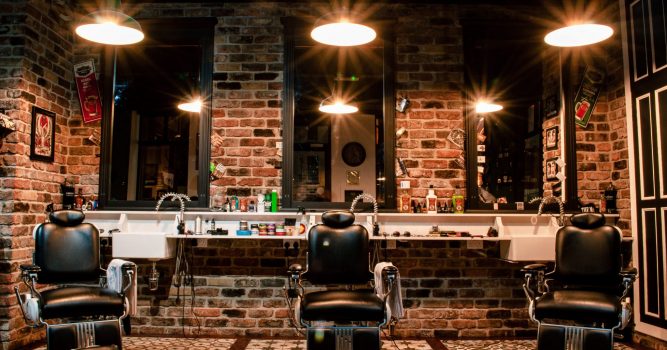Before you sign any lease on a new salon, carefully consider how much salon square footage the space offers and how you’ll be able to maximize salon productivity and revenue.
Heath Smith, the co-founder of Ruiz Salons in Austin, Texas, has two salon locations and a proven formula for maximizing salon productivity for every single square foot. These are his go-to strategies for creating a successful, sustainable salon business that thrives.
What’s The Average Salon Size?
Before we jump into tips for using your salon space, it’s great to have a general idea of how big salons typically are. Your needs will vary depending on how many stylists you have of course, as well as the types of clients you serve.
For example, you may be looking for a small, intimate space for high-end clientele. Or, your salon may serve as a hub for your community with plenty of space for retail and relaxing afterward.
Overall, though, most experts agree that the average salon size starts at around 1,500 square feet if you have more than four stylists. To maximize revenue, a hair salon square footage between 2,500 and 3,000 square feet is ideal. While not huge, it allows you to have the space for ten or more stylists and offers plenty of options for growth.
Choosing a space that’s too large or too small is a common mistake new salon owners make. Once a salon is built, there’s not a lot that can change, and it will cost a lot of money to fix what you just spent good money on.
At some point, Heath Smith says he and co-founder Allen Ruiz ultimately determined that the 5,000 or 10,000-square-foot salons of the past didn’t make sense for them any longer. He notes:
“We have one salon that’s 2,500 square feet and one that’s 2,900. I know I can run a five-day workweek with a single shift per day and make that size salon space profitable. But it also gives me room for a split shift environment and to be open seven days per week.”
Once you have a general idea of what size space to look for, here’s how to increase your revenue and make every square foot as profitable as possible.
1. Start Calculating Your Space
Smith says a good formula for how many stations you can get out of a space is to take the overall salon square footage and divide it by 150. Each stylist will need approximately that much space to serve their guests, including space for:
- Reception
- Stylist chairs
- Shampooing area
- Retail
- Office space
Smith notes: “We roughly use 20% of our space for cutting, 20% for color, 20% for back-of-house operations, like offices and break rooms, 15% for retail, and 10% for the shampoo bowls.”
How much space should be between shampoo bowls and chairs? Ideally, give your guests at least 32-42 inches between shampoo chairs, and up to 54 inches between styling chairs.
If you have the flexibility to provide more room, then consider doing so. This way guests can feel more at ease and there won’t be as much noise carrying about the space from other stylists.
2. Set Your Ideal Revenue Per Salon Square Footage
Salon experts recommend keeping your total monthly lease cost at 6-8% of total sales after year three of opening, and no more than 10% in those early years of your new salon.
Before you select a space, all the decisions you make as a salon owner—from how you staff your salon to your hours of operation—should stem from this initial number. You can figure out how you’ll reach it in a potential space by calculating your initial revenue per square foot goal.
Determining this can be tricky, as it will depend on your location, commercial rent prices, and more. Smith explains:
“Our target is to have all locations producing over $1000 per square foot annually. Revenue per salon square footage that’s greater than $500 is ideal, and plan for at least three years in business to get to that number.”
There are innovative and creative ways to figure out how you’ll meet this goal. For example, in their bigger, flagship location, Smith split shifts with 18 chairs. A team of stylists begins work at 7 AM, and then an entirely new team comes in to work afternoons through 10 PM. This model works in their urban area, allowing them to maximize their salon revenue.
It’s definitely better to have a plan in mind before you start spending money on a lease, or with an architect and contractor.
3. Avoid Common Pitfalls
Speaking of architects, work through your salon blueprint with an architect before you sign a lease. And don’t be afraid to walk away from your dream space if it’s not going to suit your salon’s needs perfectly.
For example, Smith advises being on the lookout for architectural impediments like columns or other interior structures that limit use. He says:
“You could lose 200 square feet because of a column. In the grand scheme of things, wasting 200 square feet over a 10-year lease isn’t worth it. That salon square footage could be making you money if used properly.”
What those pitfalls are will vary by each location. That’s why it pays to bring along an architect who understands salon design and can point out issues that may come up.
4. Plan Down to the Last Inch
Next, determine what’s necessary for your salon to specialize and thrive. When Smith was designing his salons, he gave the color area first priority, noting:
“Color needed its own plumbing, sinks, and bar, making the whole area a contained space. As a specialized salon, we were clear about the needs of the colorist and shared details with our architect. With the cutting stations, though, we were more flexible and have tried varying layouts over the years as space allowed.”
Find the area you want to prioritize for your salon, plan that out first, and then figure out space for:
- Different services, like waxing or spa rooms
- Shampoo areas
- Public spaces, like seating areas
- Retail
- Reception
- Back of house needs, including break rooms, storage, and laundry
Manage your builders closely and always look for ways to save on space. Smith notes: “Don’t dedicate valuable salon square footage if you can store up high or out of sight. We even built fake wall panels for paper products in the bathroom to eliminate big storage rooms.”
5. Reassess As Your Needs Evolve
You can do everything right when optimizing your salon square footage, but your business and community needs will change over time.
Smith’s salon, for instance, had a nail spa within its main location for ten years. Eventually, Smith realized the business could no longer afford to offer nails. He explains:
“The production per square foot was so low compared to hair or waxing—it couldn’t justify itself. We couldn’t generate the dollars per square foot the way we wanted to. Even though clients still wanted it, we converted the space to waxing, which was much more profitable. Don’t be afraid to question the original build-out decisions you made as time passes and the economy changes.”
While these tips can help you make the most of your salon square footage, set aside time every quarter or every year to reexamine what’s working and what isn’t. Only with continuous improvements will you be able to truly maximize your salon revenue per square foot.
Get Help Growing Your Salon
Once you’ve made every square foot of your salon valuable, it’s time to create a jaw-dropping experience for every guest who walks through your doors. SalonBiz can help. With convenient online scheduling, team management, and automated text message reminders, you’ll keep your chairs full and guests happy for years to come.
Book a demo to learn more about our comprehensive salon management software today.








